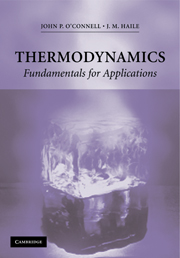Book contents
- Frontmatter
- Contents
- Preface
- Acknowledgments
- THERMODYNAMICS: Fundamental for Applications
- 0 Introduction
- PART I THE BASICS
- PART II SINGLE-PHASE SYSTEMS
- PART III MULTIPHASE AND REACTING SYSTEMS
- PART IV ENGINEERING CALCULATIONS
- 10 Options for Equilibrium Calculations
- 11 Elementary Computational Procedures
- 12 Selected Applications
- AFTERWORD
- APPENDICES
- Notation
- Index
12 - Selected Applications
Published online by Cambridge University Press: 05 June 2012
- Frontmatter
- Contents
- Preface
- Acknowledgments
- THERMODYNAMICS: Fundamental for Applications
- 0 Introduction
- PART I THE BASICS
- PART II SINGLE-PHASE SYSTEMS
- PART III MULTIPHASE AND REACTING SYSTEMS
- PART IV ENGINEERING CALCULATIONS
- 10 Options for Equilibrium Calculations
- 11 Elementary Computational Procedures
- 12 Selected Applications
- AFTERWORD
- APPENDICES
- Notation
- Index
Summary
When we apply thermodynamics to industrial and research problems, we should draw fundamental ideas from Parts I and II, devise an appropriate solution strategy, as in Chapter 10, and combine those with a computational technique, as in Chapter 11. Such a procedure provides values for measurables that can be used to interpret novel phenomena, to design new processes, and to improve existing processes. The procedure is illustrated in this chapter for several well-developed situations. They include conventional phase-equilibrium calculations for vapor-liquid, liquid-liquid, and solid-solid equilibria (§ 12.1); solubility calculations for gases in liquids, solids in liquids, and solutes in near-critical solvents (§ 12.2); independent variables in steady-flow processes (§ 12.3); heat effects for flash separators, absorbers, and chemical rectors (§ 12.4); and effects of changes of state on selected properties (§ 12.5).
PHASE EQUILIBRIA
When two or more bulk phases are in contact and at equilibrium, the measurables of interest are usually temperature, pressure, and the compositions of the phases. Of these measurables, the most important are often the compositions; for example, in the design and operation of separation processes, we routinely need the composition of a particular phase, or when the temperature and pressure change, we need to know the extent to which the compositions also change. When engineering applications involve fluid-fluid equilibria, we often find that, besides absolute compositions, relative compositions can be informative and important.
- Type
- Chapter
- Information
- ThermodynamicsFundamentals for Applications, pp. 529 - 584Publisher: Cambridge University PressPrint publication year: 2005



